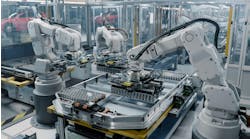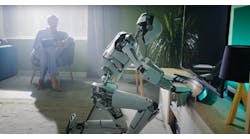The popularity of industrial robots used in automated machines has never been higher; but a robot is many things, and we are just scratching the surface. The robots we are using now aren't good enough. While I know there have been upgrades and improvements to the hardware, controllers and programming used in robots, not much has changed over the past 30 years. We need more innovation in robotics to build these new, advanced robots in America.
For a little motivation, “Advancing Robotics to Boost U.S. Manufacturing Competitiveness,” a report published by Boston Consulting Group and co-authored by Howie Choset, robotics professor at Carnegie Mellon University’s School of Computer Science, argues that a thriving domestic robotics industry will help to enhance America’s competitiveness in the global economy.
"It's fair to say that, in the industrial-robot world, there are no American robot manufacturers," says Choset. "Although a lot of the robot applications are used in U.S. manufacturers, the robots were built by European or Japanese manufacturers. I think we need to create an ecosystem in the United States where industrial robot manufactures can actually evolve."
I personally remember looking out over an automotive body shop in a large manufacturing plant about 30 years ago. There were a bunch of articulated-arm robots—about 200 of them—picking body panels from power and free conveyors, placing the panels on automotive chassis, spot-welding the parts together and performing other assembly operations. The problem is that the only thing that has really changed over the past three decades, outside of collaborative robotics, is that this type of automation is becoming popular in other manufacturing plants outside of the automotive industry. The United States cannot just use the off-the-shelf robot; more advanced robotics are needed to be competitive in manufacturing globally.
We need to think differently for robots to evolve. "Maybe the way to do that is to think about the next robot, and not just one that looks like and competes with the existing systems," says Choset. "I think the next robot has to be better at performing assembly operations and performing all sorts of manipulations other than grabbing a part and placing it."
The robot needs to grab a part and move it around with little development time needed, continues Choset. "Or perhaps the next generation of robots has to manipulate soft materials, even textiles," he says. "That's where there is great potential. While not a future prediction, if I were to put all my eggs in a basket, I would start developing robotic systems that can manipulate textiles."
Robotics are more than just an articulated arm of some type; it must include all of the senses. "In our lab, we do a variety of things," says Choset. "We have developed new kinds of robots that can feel their surroundings when they press against a surface or grab a small part. It’s not only the knowledge you have the part but the reaction forces one would feel when grabbing something. We have also gotten very good at developing force sensors that work well when it is necessary to press on something or palpitate during surgery."
The robotics will need sensors to close the loop on both the human side and robot side. "Some of the things we are developing are either collaborative providing information that a human can use or more collaborative in that they perform a manipulation near a human or they're extremely more collaborative in that they perform the manipulation with the human completing a shared task," says Choset. "There is a whole spectrum of things you can do. In all these examples, there is a way to close the loop. It's something we spend a fair bit of time worrying about."
Originally, I was thinking that a big part of advancing robotics was to attach a fancy end effector, a vision system and a little AI on an off-the-shelf robot, but the innovation needed is beyond the now-common tooling and control hardware. But there’s a problem. "You have to remember that, when you do that, you are also spending four to five times the cost of the robot in what amounts to customized integration every time", says Choset.
"Wouldn't it be great if 80% of that customized integration was as simple as downloading an app?” asks Choset. "What we need to do is advance our robots, so they are easier to install and more flexible, making them readily applied and often redeployed. They shouldn't need all the time-consuming integration or customization. It's an area to invest in."
A robot, by default, should be able to identify a part, grab it, orient it, move it about and pass that part and the information the robot collected about it to other automation devices and tooling. That is not standard yet. When I need to read my computer screen, I automatically complete a common sequence. I look at my desk. I find my computer glasses, not my reading glasses. I pick them up, automatically orient them and carefully place them on my nose and ears without poking out an eye or dirtying up a lens. The innovation needed is to make a robot perform these and similar functions with little development time. Just throw the switch, and go fetch.
"Another thing we are working on which feeds into the flexibility is modular robots," says Choset. "My group started making these snake robots. The snake is the same electromechanical module over and over again; it's the same joint, head to tail. Now that we are building modular robots, we are not limited to the snake morphology. We build a six-legged robot, robot arms and bipedal robots. Due to the modularity, we build lots of good robots very quickly. My lab has an explosion of robots. Even more exciting is other people are using our robots to do other tasks that we never thought of."
Based on Choset's comments, it's time to develop self-taught robots, with sample cases instead of programming, where the robots figure out the work and are more versatile, available at a lower price and made in the United States, enabling competitive manufacturing at even a small scale.






